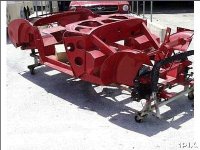[ QUOTE ]
i have noticed that many have looked at the post. have any of you had problems with the doors binding at the top of both front and rear. if so anybody got any advice. if it will help i have pics to share just e mail me your e mail address and i will send you the pics.
shane
[/ QUOTE ]
I would approach this car from a different angle than that mentioned above...
Assuming that you have an otherwise decent car (runs/drives, etc.) and the only issue you have is the door gaps (that's the only thing you mentioned). I would leave the car assembled and address the sills and rockers individually.
I made up a pair of fixtures that go across the door openings while the door remains on the hinges:
In the view shown, the fixture would be fitted to the inside of the right door aperture. The clamps pinch the lip that the weatherstrip attaches to and still allow the door(s) to close. The fixture allows you to "jack" the screws to align the door gaps top & bottom.
With the fixtures set and locked down for both sides, you can replace the sills/rockers one side at a time.
I prefer to do the (floors, outriggers,) sills & rockers BEFORE taking the car apart. Why remove all the weight only to add it back? Once the rough and tumble work is done, you can either paint the repaired areas, or disassemble for a ground up restoration.
Here are a few more shots of the fixture(s) to show details:

 Hi Guest!
Hi Guest!

 smilie in place of the real @
smilie in place of the real @
 Pretty Please - add it to our Events forum(s) and add to the calendar! >>
Pretty Please - add it to our Events forum(s) and add to the calendar! >> 



